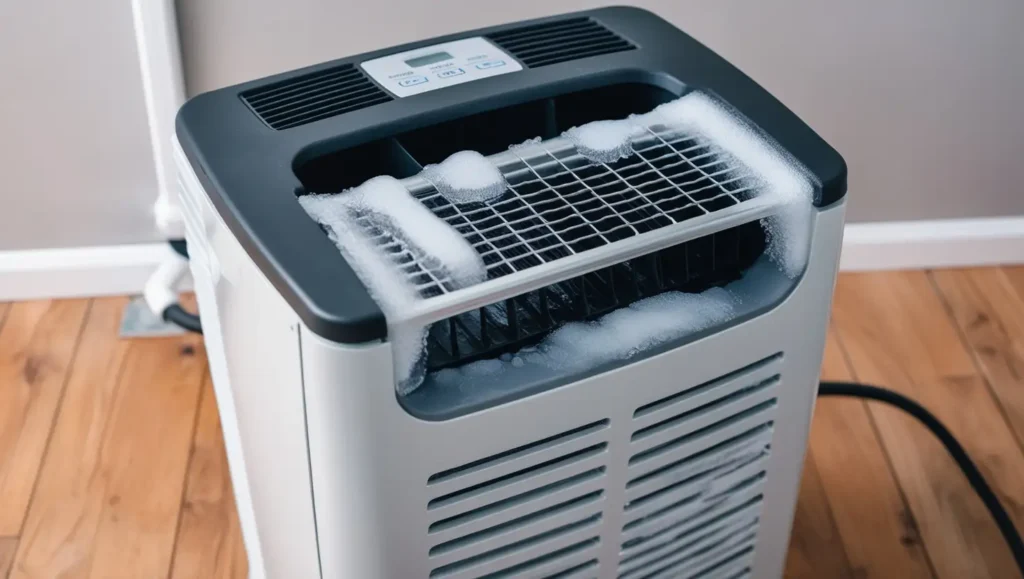Why Dehumidifier is Freezing Up and How to Fix It
There are many reasons behind your dehumidifier getting frizz up. It can happen because of leakage, dirty evaporator or filter and if the temperature of your place is lower than 17 degrees Celsius. People have been facing this kind of issue since dehumidifiers were invented in 1902. Still a lot of people are unaware of its solution. In this blog, i am gonna explain point-wise all the reasons and possible solutions so that things get easier for everyone.
If your dehumidifier getting freezing, then follow those steps:
Step- 01: Melt the ice
Turn off your dehumidifier, and remove the electrical connection. So that all the ice completely melts. wait till all the ice melts and after this, check the condition of the evaporator, condenser and air filter.
Step- 02: Clean the air- filter, Evaporator and condenser
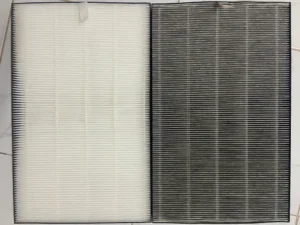
Air filter: First clean the Air filter. Because if the filter is dirty, then the blower fan can’t suck the air inside the dehumidifier. For that reason the moisture inside the dehumidifier gets so cold and freezes over the evaporator. Cleaning the air filter is very easy, you can use a brush or vacuum cleaner, you also can wash it, if you want to. Once the air filter is clean and dry, then install it properly.
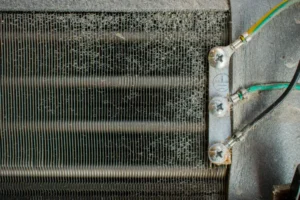
Evaporator and condenser: If the place around the dehumidifier isn’t that clean, then it’s obvious that the evaporator and condenser will get dirty very soon. Because of that, when the water gets to stack with the evaporator, the dirt will absorb water from it, after this stack water will freeze because of the low temperature of the evaporator.
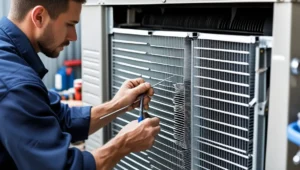
You have to clean the evaporator and condenser carefully, otherwise you can damage the radiator.
If you see that it’s already damaged then, you can fix it with a thin stick or a hair comb. The better option will be if you buy a radiator fixer from Amazon.
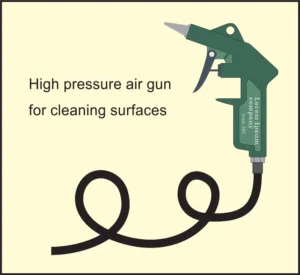
While cleaning, first use a high-pressure air gun, after that use a radiator brush to clean both the evaporator and condenser.
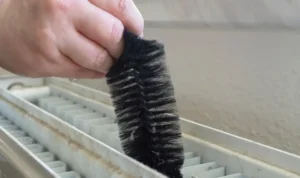
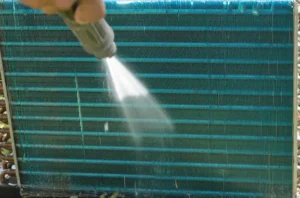
Now finally you can wash it with water. If you follow those processes you can fully clean both the evaporator and condenser but to get long service you should make the place clean around the dehumidifier.
Step- 03: Leakage issue
Leakage is not something that commonly happens to everyone. When someone uses a dehumidifier for a long time, if some kind of physical damage happens to it or because of vibration issues in the long term leakage can happen. And due to leakage, the cold refrigerant gets released slowly. Because of that, all the moisture freezes over the evaporator, also the water pot in the dehumidifier gets frozen. Let’s talk about the solution.
This is a very critical issue compared to others. When all the refrigeration gas gets released from the system, the dehumidifier will stop working. Only the blower fan will run, otherwise the dehumidifier will not absorb any moisture from the air. And the ice in the dehumidifier will melt. If you see that in your dehumidifier there is a freeze issue and after 1 or 2 days the ice has melted and now only the fan is running but it’s not absorbing moisture from the air, that means there should be a leakage issue. Also if you see nothing is operational in the dehumidifier including the blower fan, then electrical power availability issues can happen.
To fix it, 3 things need to be completed. 1) pressure test & leakage fixing out. 2) vacuum 3) Refrigerant gas charge.
pressure test & leakage fixing: To find out the leakage pressure test work must be done. Normally nitrogen gas is used for pressure test work. Use 200/250 psi pressure for it. After the pressure test, check the pressure meter every 3 or 4 hours. If you see the pressure has reduced, then again do it and put the soap water in the condenser or evaporator. If you see bubbles in the parts that means you find the leakage. Now fix it with a brazing rod and weld it. And if you think the parts are very small or it is damaged very badly then change the parts. After that do the pressure test again and no if the pressure doesn’t decrease then it’s time to do the vacuum.
Vacuum: There isn’t much gas in a dehumidifier. Because of that vacuum work will not take much time. Vacuum menace, we need to get out all the nitrogen gas from the system and other gas can’t be there. So that we can proceed with the refrigerant gas charge work.
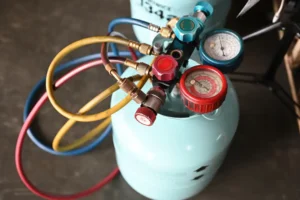
Refrigerant gas charge: Like air-conditioner, In dehumidifiers we use R134a or R410A refrigerant gas. You can choose one of them or your refrigerant brand prefer any specific refrigerant gas, then go with that. Here you will require a maximum 250 to 350 Gram gas, depending on the capacity of the dehumidifier. Make sure the pressure is 110/120 psi. Once the refrigerant gas charge is done, now it’s time to put it on.
If your dehumidifier is too old, then just put in some more money and get a new one. Because to fix leakage the technician will charge high and if you need to change any parts then going for a new one will be a smart choice.
Before buying a dehumidifier, make sure it has a defrost or passive defrost mode. Those modes will help your dehumidifier to maintain operation in cold places.
Defrost mode:
In cold areas, sometimes dehumidifiers freeze up and for those issues, companies provide this mode. The old model dehumidifier has this setting. In cold weather, compressor-based dehumidifiers get frizzed. Defrost mode was invented to avoid this issue. what it does is, it automatically turn off the refrigeration cycle of the dehumidifier and it will only run its fan. So this fan slowly melts the ice from the dehumidifier. After the ice is fully melted, it runs again.
Passive defrost mode:
Companies now provide passive defrost mode in modern dehumidifiers. It is an optimized version of the deforest mode. In this mode, the dehumidifier is not actively dehumidifying, but still, it consumes electricity. So this mode is less efficient compared to the deforest mode but provides a high value.
This mode allows the dehumidifier to operate at a very low temperature. We know that the compressor-based dehumidifier gets frizzed, if we use it in a place where the temperature is lower than 17/18 °C. But because of this mode, now the dehumidifier can run at 5°C temperature. At this temperature, it runs in a very low setting. This is crazy that modern dehumidifiers are improving so much. For more lower temperature go for the desiccant dehumidifier.
In cold places why refrigerant dehumidifiers freeze:
The evaporator of the dehumidifier is cold, if the temperature in your area is less than 17 degrees Celsius, then the moisture in the air or the H2O molecules are already cold. So when they enter the dehumidifier this cold moisture becomes more cold and freezes over the evaporator. for that reason in cold areas, you should go for the desiccant dehumidifier, not the refrigerant dehumidifier.
If anyone still doesn’t understand it, why do refrigerant dehumidifiers freeze? Then I suggest you look a little bit at the refrigeration cycle or how the refrigerant dehumidifier works. Here I am describing the working principle of the dehumidifier in a very short and easy way.
Refrigerant dehumidifier working process:
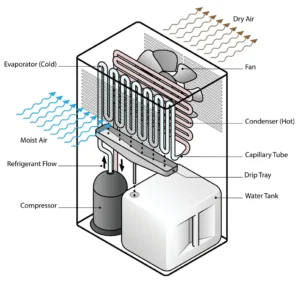
A refrigerant dehumidifier works exactly like an air-conditioner. Their working process is based on the refrigeration cycle.
Inside a dehumidifier, there are an evaporator, condenser, compressor, expansion valve and blower fan, these parts are contained within a single unit, which is called a dehumidifier.
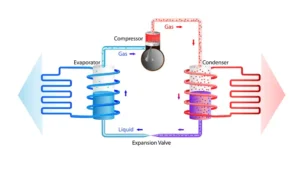
In a refrigerant dehumidifier, chilled or cold liquid refrigerant flows to the evaporator and for that reason the evaporator gets colder than the room temperature. In front of the evaporator and condenser, there is a blower fan that inhales room air into the dehumidifier. When room air enters the dehumidifier and comes to the evaporator, heat exchange happens between both of them. Because the evaporator temperature is very low compared to the room temperature. Here the evaporator absorbs heat from the room air. The moisture around the evaporator gets heavier by losing heat and they stack on the evaporator. This stuck water drain to the water pot or outside drain line. In the meantime the chilled/cold liquid refrigerant converts to gas by absorbing heat from room air.
The refrigerant is now in a low pressure hot gaseous state, this low pressure gas goes to the compressor, compressor compresses and it becomes superheated gas. This high-pressure, superheated refrigerant gas then flows to the condenser, where it loses heat and returns to its liquid state.
In a condenser how is it losing heat? It’s happening because, unlike the air conditioner, in the dehumidifier evaporator and condenser are installed side by side. When room air loses heat in the evaporator by heat exchange process, the air becomes cold and before it comes back into the room it goes through the condenser. Here another heat exchange process happens and as we know the refrigerant in the condenser is very superheated, for that reason the cold air absorbs the heat from the condenser and gets back to the room at normal temperature. At this point, the refrigerant gas gets cold and becomes liquid again.
The liquid refrigerant passes through the expansion valve, which reduces its pressure and sends it back to the evaporator, fulfilling the cycle. This is how the evaporator always keeps cold in a running refrigerant dehumidifier.
This is how things work. I hope you get all the information regarding a Dehumidifier freezing up issue. If you love to do things by yourself, I believe that except for leakage, you can solve others’ problems.

